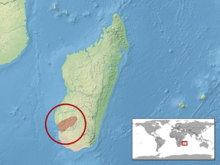Standing's day gecko
| Standing's day gecko | |
|---|---|

| |
| Female of Phelsuma standingi, with prominent endolymphatic chalk sacs | |
| Scientific classification | |
| Domain: | Eukaryota |
| Kingdom: | Animalia |
| Phylum: | Chordata |
| Class: | Reptilia |
| Order: | Squamata |
| Family: | Gekkonidae |
| Genus: | Phelsuma |
| Species: | P. standingi
|
| Binomial name | |
| Phelsuma standingi | |

| |


Standing's day gecko (Phelsuma standingi) is an
Etymology
The generic name, Phelsuma, is a Latinized version of the last name of Dutch physician Murk van Phelsum.[3] The specific name, standingi, is in honor of another physician, Doctor Herbert F. Standing of Antananarivo, Madagascar.[4]
Description
P. standingi is among the largest
It is a sexually dimorphic species. In the males the cloacal area has very pronounced preanal pores and a bulge in the area of hemipenis. In many females two endolymphatic chalk sacs, located on each side of the neck, are well-developed, while in males usually they are just barely visible. These sacs store calcium, which is needed for the formation of egg shells.[5]
Distribution and habitat
P. standingi is restricted to the arid southwest of Madagascar, specifically the region around Andranolaho, Sakaraha and in the Zombitse-Vohibasia National Park. This area has a unique thorn forest vegetation. The daytime temperature never drops under 20 °C (68 °F) and between January and December, the temperature can be as high as 40 °C (104 °F) in the shade. In July and August, the night temperature can drop to 13 °C (55 °F).[6]
Diet
Standing's day gecko feeds on various insects, invertebrates, and even smaller lizards. It is omnivorous, however, supplementing its prey with soft, sweet fruit, pollen and nectar.[7]
Behaviour
Strictly an arboreal and diurnal species, P. standingi lives in pairs on trees, spending a lot of time basking in the sun on the highest and well exposed branches. The males are very territorial and will fight when in the presence of other males; females have this character towards other females, a behavior which is rather rare in geckos.[5]
Reproduction
P. standingi is oviparous. At a temperature of 28 °C (82 °F), the young will hatch after approximately 60–70 days. The juveniles measure 80 mm and reach sexual maturity after one year.[5]
In captivity, Standing's day geckos can be expected to live up to 15-20 years when appropriately cared-for.
References
- . Retrieved 19 November 2021.
- Methuen, P. A. & Hewitt, J. (1913). "On a collection of reptiles from Madagascar made during the year 1911". Annals of the Transvaal Museum. 3 (4): 183-193.
- ISBN 978-1-4214-0135-5.
- ISBN 978-1-4214-0135-5.
- ^ a b c d Bartlett, R.D. (1993). "Notes on Standing's Day Gecko (Phelsuma standingi )". Tropical Fish Hobbyist. T.F.H. Publications: 146–150.
- ISBN 978-1-84162-557-7.
- ISBN 978-0-7938-0222-7.
Further reading
- Henkel, Friedrch-Wilhelm; Schmidt, Wolfgang (1995). Amphibien und Reptilien Madagaskars, der Maskarenen, Seychellen und Komoren. Stuttgart: Ulmer. ISBN 3-8001-7323-9. (in German).
- McKeown, Sean (1993). The general care and maintenance of day geckos. Lakeside, California: Advanced Vivarium Systems.

